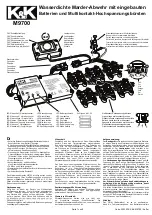
8
Figure 9 shows the CTs on the neutral side of
the generator. This location allows the relay to
sense internal generator faults but does not
sense fault current coming into the generator
from the external system. Placing the CT on the
system side of the generator introduces a
problem of the relay not seeing a generator
internal fault when the main breaker is open and
when running the generator isolated from other
generation or the utility. If an external source
contributes more current than does the genera-
tor, using CTs on the generator terminals, rather
than neutral-side CTs, will increase 51 relay
sensitivity to internal faults due to higher current
contribution from the external source; however,
the generator is unprotected should a fault occur
with the breaker open or prior to synchronizing.
Voltage-restrained or voltage-controlled time-
overcurrent relays (51VR, 51VC) may be used as
shown in Fig. 11 to remove any concerns about
ability to operate before the generator current
drops too low. The voltage feature allows the
relays to be set below rated current. The Basler
BE1-951, BE1-1051, BE1-GPS100, and
BE1-51/27R voltage restrained approach causes
the pickup to decrease with decreasing voltage.
For example, the relay might be set for about
175% of generator rated current with rated
voltage applied; at 25% voltage the relay picks
up at 25% of the relay setting (1.75*0.25=0.44
times rated). The Basler BE1-951, BE1-GPS,
and BE1-51/27C voltage controlled approach
inhibits operation until the voltage drops below a
preset voltage. It should be set to function below
about 80% of rated voltage with a current pickup
of about 50% of generator rated. Since the
voltage-controlled type has a fixed pickup, it can
be more readily coordinated with external relays
than can the voltage-restrained type. The
voltage-controlled type is recommended since it
is easier to coordinate. However, the voltage-
restrained type will be less susceptible to
operation on swings or motor starting conditions
that depress the voltage below the voltage-
controlled undervoltage unit dropout point.
FIGURE 11. VOLTAGE-RESTRAINED OR VOLTAGE-
CONTROLLED TIME-OVERCURRENT PHASE FAULT
PROTECTION.
Fig. 12 eliminates concerns about the decay rate
of the generator current by using an instanta-
neous overcurrent relay (50) on a flux summation
CT, where the CT window can accommodate
cable from both sides of the generator. The relay
does not respond to generator load current nor to
external fault conditions. The instantaneous
overcurrent relay (50) acts as a phase differential
relay (87) and provides high-speed sensitive pro-
tection. This approach allows for high sensitivity.
For instance, it would be feasible to sense fault
currents as low as 1-5% of generator full load
current. It is common to use 50/5 CTs and to
use 1A nominal relaying. A low CT ratio intro-
duces critical saturation concerns (e.g., a 5,000A
primary fault may try to drive a 500A secondary
on a 50/5 CT). The CT burden must be low to
prevent saturation of the CT during internal faults
that may tend to highly overdrive the CT second-
ary. The 51 relay shown in Fig. 12 is applied for











































